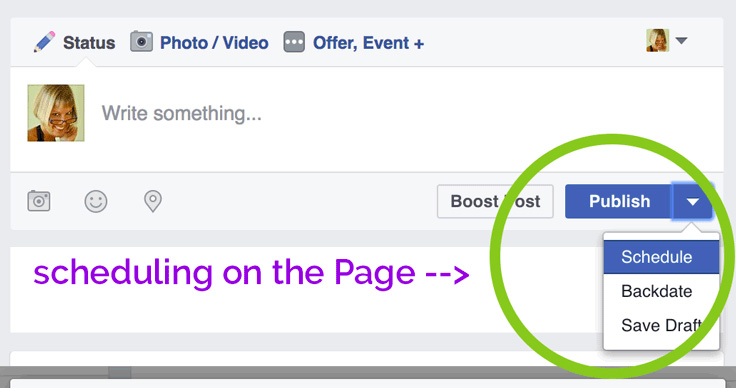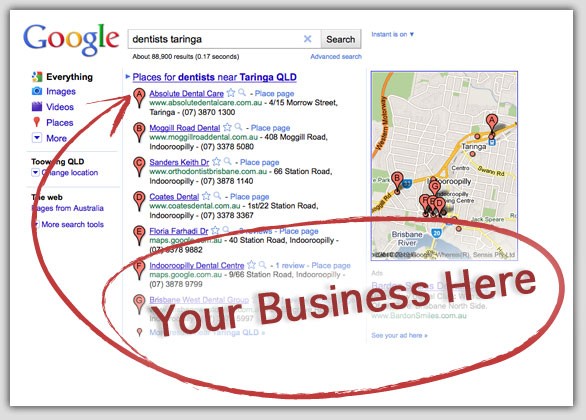2 Davids Web Design, Hosting & Technology
Ever wonder how people have time to keep their Facebook pages for their businesses and organizations up-to-date?
With Facebook's Schedule option for posting, keeping your social media outreach to your followers is now a simple process.
Take one day a month to sit down for an hour and create content to post to a future date and time for your followers.
Why should I schedule Facebook posts ahead of time?
As a business owner, you probably have a lot of content to share—and not a lot of time to do it. Scheduling your Facebook updates in advance can save you time and hassle.
Benefits of scheduling your Facebook posts:
- Reach multiple time zones—Schedule Facebook posts in advance to reach audiences around the world.
- Improve consistency—Being consistent with your updates—how often you post and when—will tell your audience when to expect new content. Avoid pauses or sudden breaks in your social media schedule to help ensure maximum engagement.
- Build anticipation—Draw your audience towards a big event, announcement, or product launch. Scheduling multiple messages to promote an event is a great way to build anticipation.
- Future Promotions—Have a promotion or sale coming up? Create it now so you can work on the other tasks involved with your busy life.
How to schedule Facebook posts on Facebook
Here’s a step-by-step on how to schedule future posts for your Facebook Page:
How to schedule a post on Facebook:
- Start creating your post at the top of your Page’s Timeline
- Click the dropdown button next to Publish and select Schedule
- Below Publication, select the date and time when you want the post to publish
- Click Schedule
How to reschedule, edit, or delete a scheduled post on Facebook:
- Click Publishing Tools at the top of your Page
- Click Scheduled Posts in the left column
- Click the post you want to edit
- Click Edit to edit the post, or click the dropdown button to choose to publish, reschedule or delete it

We offer this service to assist you if you provide to us either content or the ideas you are trying to get out there. Email us at This email address is being protected from spambots. You need JavaScript enabled to view it. and we can help.
Add a call-to-action (CTA) button to your cover photo.
Back in December 2014, Facebook launched a new feature that allows you to add one of seven pre-made call-to-action buttons to your Facebook Page's cover photo. Pages can choose from one of the following options -- "Sign Up," "Shop Now," "Contact Us," "Book Now," "Use App," "Watch Video," and "Play Game" -- and customize it with a destination URL of their choosing.
This is a great way for marketers to drive traffic from their Facebook Business Page back to their website. Check out how Hotel Urbano uses the "Book Now" button on its Facebook Page:
Another smart way to use these calls-to-action is to integrate your Facebook cover photo with your CTA button.
To add a call-to-action button to your cover photo, click the 'Create Call-to-Action' button located on your cover photo. You'll then be able to choose the button copy you want and specify the URL you want to direct visitors to. To get data on how many people are clicking your button, simply click the drop-down arrow on your button and select 'View Insights.'
Already have a website and need a better hosting plan both for price and dedicated technical support from yes, America?
If you need domain names check our site here to see if they are available. Once your domain name is purchases you need a place for the website files, databases and emails to go. That is what web hosting is:
When you search for keywords in your web browser related to your brand in Google search, you want to dominate the first page of results. How do you make sure you show up in the top ten results, not in the top 100? Optimize your Facebook brand or company page.
Just as there are ways to optimize your website for search engine rankings, there are a few tricks we can apply to your Facebook fan page to ensure that it ranks higher in the search engine results pages (SERPs). Since Facebook is such a strong site in and of itself, applying a few of these best practices to your fan page will greatly improve the ability of the search engines to crawl and index your page and rank it for your keywords in the search results.
Why do you care about the rankings of your fan page? Higher rankings in the search engines means more visibility for your fan page, more visibility means more clicks to your fan page, which can push your customer along the sales cycle into the awareness or action stages. Your fan page works in sync with your website also because in the search results pages for your keywords, you want to dominate the screen with your own web properties. Facebook is probably your strongest social profile on the web, so let’s get started with the top Facebook page SEO tactics:
1. Customize your Facebook page’s URL
After your page has 25 likes, you can claim your vanity URL for your brand. This vanity URL means that it will be easier to remember the Facebook page’s URL when talking to customers or adding to advertisements. Additionally, having an optimized URL has SEO benefits as well, as an optimized URL gives the search engines a clearer metric to know what the Facebook page is about.
Select your page name from the drop down and you can change the URL (username).
The customized vanity URL is changed by changing your username. This username does not affect your Facebook login, it will only appear in the URL. Choose your company name and add a keyword if it makes sense, but avoid keyword stuffing. Names are chosen at www.facebook.com/username.
2. Optimize your Brand or Company’s Name
An example of a clear, clean page name.
The Facebook page name should be your brand or company name and nothing else. Avoid stuffing in keywords or extra text. This is not the place to add your targeted keywords or special offers. When users are taking that second to decide whether to like your page or not, the page title makes a huge difference.
3. Fill out your Info Thoroughly
An example of good brand information.
Make sure you thoroughly fill out the information about your page and add in descriptive keywords. This section offers a lot of opportunity for your Facebook page optimization. Depending on whether your page is for a brand, company, or artist, these fields will change slightly. Write informative, descriptive copy that highlights the best of your brand and includes a few keywords that you want to be found for.
4. Link to your page from around the web
Encourage users to follow your Facebook page with a link from your website
The more links coming into your page from other websites around the web, the more authoritative Google will think your page is. You can influence this by linking to your fan page from your website and any other social accounts you have. Examples of this would be your Twitter account, Google+ personal account, LinkedIn profile, Quora profile, and any niche social sites such as Etsy. You can also guest post on blogs and get a link back to your website and Facebook page.
5. Encourage internal Facebook links to your page
Poll your fans to encourage interaction and more Likes.
Internal links from Facebook fans and their profiles are important as well. This method goes hand in hand with engaging and interacting with your fans. You do not specifically get links to your page from other users, but by building up your fan base, you will have more links to your page from personal profiles. Take it one step further by interacting with your fans by asking call to action questions in your status, by using polls to survey your fans, and by sharing exclusive photos and videos that encourage comments. When search engines crawl your Facebook page they will take into account the social interaction with your page from other Facebook users as a positive ranking signal.
Basic Checklist for How to Rank in Google Places
Article from Web Market Today - Written by Chris Silver Smith
How to rank in Google Local Searches:
Google Place Search, and Google Maps is mystifying to many small business owners. I’ve tried to cut through the complexity and misinformation with this simple checklist.
If you’re wondering how to enable your business to rank well when people search for your products and services in your city and area, these tips can help you establish yourself pretty thoroughly. Since many businesses do a poor or haphazard job of optimizing themselves to be found in local search results, just following the steps in this checklist may position you for some of the top rankings for your type of business in your city.
This checklist is in rough order of importance, and some of the steps are a bit sequential. So follow the list in order.
How to Rank in Google Places Checklist
- Select a good domain name. If you don’t already have one, select a good domain name for your website. Go with a domain name that reflects your business’s name or the business category name for your company, such as “SmithBrosAtlantaPlumbers.com” or “AtlantaPlumbers.com.” For more in-depth suggestions, read my personal blog post “Local SEO 101: Domain Naming.”
- Have a good website. It doesn’t have to be expensive or include tons of bells and whistles. Don’t try to out-do others or you might pay too much money or become paralyzed by trying to get it built and published. In fact, Google can more easily interpret simpler websites. When deciding how to set it up, use WordPress as a content management system, because WordPress has an automatic advantage in search rankings, fresh out of the box. Not to mention, using WordPress makes it easy for nontechnical people to perform simple updates and redesign the look of the site rapidly in the future. See “SEO Friendly URLs for WordPress,” my previous post.
- Use descriptive text on home page. Make sure the name of your business and the category and city names are in the title of your website’s home page. See my previous post on “Using the Home Page to Improve Local Search Rankings.”
- Include your phone number and street address on the site’s home page and contact or locations page. Also, if you offer services to a number of distinct neighborhoods, districts, or city names in your area, it can’t hurt to list these areas in an “Offering Services To” section on your home page.
- Perform keyword research. Use the right keywords to make your business findable by the majority of consumers seeking your type of company. Don’t assume you know the most-popular phrases used to find your business; research keywords with Google tools to be sure, and to discover related phrases that may have become recently popular. Incorporate the keywords you discover throughout the written text in your site.
- Include “services” or “products” pages on your site over time. You don’t have to do everything at once — your site can be a growing asset, and as you include more information about what you do and what you offer, the site can become more and more robust in keywords that Google can match up with user searches. See my previous post, “12 Quality Signals that Improve Rankings,” for additional standard items to add to your site to beef up the search engines’ trust of your company.
- Expand your basic business information. Add other basic information to your business website that people commonly look for. This includes: hours of operation, maps and driving directions, menus, prices, amenities, cost or quality differentiators, discounts and special offers, seasonal events, and the names of owners and employees.
- Establish local citations. “Local citations” are any online mentions of your company, especially mentions with the phone number or business address. So, getting your business listed in a good number of high-quality online directories is vital. The more high-quality sites appropriate for your type of business you can get listed in, the better. Think of online yellow pages like YellowPages.com, Superpages.com, andCitysearch.com. Also think of reviews sites like Yelp and Angie’s List, as well as category-specific “vertical” directories that match your business type, such asHotels.com for hotels, FindLaw for lawyers, Contractors.com for contractors, andUrbanspoon for restaurants. Building out your business listings and business profiles on all of these sites helps rankings a lot, but it’s also time consuming and the details can be tricky. There are companies — such as Universal Business Listing, Neustar’s LocalEze, and Infogroup’s Express Update. — that help distribute your listing information to major directories and local search engines. It may be wise to use one or more of them for this purpose. Read “Local Search: Understanding ‘Citations’ to Improve Rankings,” my earlier post, for more information about citations.
- Develop inbound links. Links continue to be important and influential to search engine rankings, so developing links to your site is important. The work to establish Local Citations also results in more links from reputable sources, so you may not need to obsess about this tip so much if you’ve done the other. Link building is also fraught with risk, since so many people do it in a poor manner, resulting in getting penalized. To read up on what not to do, check out my post on “How Not To Build Links For SEO.”
- Claim your listing in Google and Bing. Once your listings have been distributed for a couple of months, chances are that Google and Bing will have absorbed your business information into their local databases and will begin displaying them in local searches and map searches. To check this, search by your business name in maps for your area, and see if your listing is shown in the search results. You can click to view the business information in the search engines, and then select to claim the listing to update it. If your listing hasn’t already appeared, you can wait patiently, or you can try to jump-start the process by adding your listing. Usually the claiming or verification process takes a few weeks, because Google and Bing will call you or send a postcard to make sure your business is located where you say and that you have authority to update the information. Once you have access to update, carefully select business categories, and add as much relevant information about your company as you can. Coordinating your Google Place listing with your company’s Google+ page is still tricky at the time of writing this. You may want to explore your options carefully or tap a professional to help navigate this.
- Integrate with Google+ Local. Coordinating your business information with Google+ is advantageous as Google continues to promote that service. Setting up a personal profile on Google+ for yourself or for a prominent employee at your business can help make your search listings more attractive, since the profile picture of your personal profile may be displayed with pages of your site in Google if you set it up correctly. To do this, read my article, “Authorship: The Top Search Marketing Tactic in 2013.” Read, also, “Google+ Local Creates Need For ‘Local Social’ Strategy,” my previous article, for more context.
- Blog. Seriously, just start blogging about things involving your company and your industry or products. Blogging provides a means of developing the keyword content of a site over time. Moreover, blogging is significantly rewarded by the search engines. It also provides you with a format for creating numerous “doors” by which consumers could come into your business. If your site is configured on WordPress, then it won’t take much to set up the blog section and begin blogging. Blogs also provide fodder for social media updates, which is the next tip in our checklist. Read more in “Your Blog is Key to Search Engine Optimization.” Also, decide how you want to set up your blog: a subdomain or a subdirectory.
- Dive into social media. Social profiles and social media update posts can provide a constant influx of citations and links for your business. Google and Bing are increasingly using unique social signals for ranking determinations, too. Integrate with the social media services that make sense for you. Facebook, Twitter, Google+, LinkedIn, Pinterest, Flickr, Instagram, YouTube, and Tumblr are all influential. Also,social media check-in services help local SEO, too.
- Optimize images. If your business lends itself to visuals, read ways to optimize for local rankings via images for tips on leveraging images on your site and in social media sites like Pinterest and Flickr.
- Develop your business’s influence and engagement levels in social media.Numbers of followers are good, so long as those followers are also influential and engaged. Klout and Kred are both free services that can help you get an independent picture of how much influence and engagement levels you’re achieving for your business through social media.
Summary
If you’re in a hotly contested category and market area, you might have to go to a lot more effort than merely accomplishing these basics. Just think about it. If you’re in a city where there are hundreds or thousands of businesses similar to yours, and Google only displays the top seven businesses on the first page of search results, chances are good that many of your competitors are also doing the basics. If you need more advanced, aggressive work, consider hiring a professional to assess your local search optimization program and get recommendations and help for improvement.
But, for a great many businesses, these basics will give a leg-up, and even an advantage, since so few companies are doing all of these things or even doing all of them well or consistently. Local SEO isn’t rocket science. But it takes concerted effort and consistency to achieve and keep top rankings.







